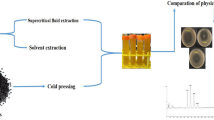Abstract
Supercritical CO2 fluid extraction (SFE-CO2) of Zanthoxylum bungeanum (Z. bungeanum) seed oil was investigated. To optimize the SFE process, three-level Box-Behnken factorial design and response surface methodology (RSM) were applied to optimize the extraction conditions, including pressure, temperature and amount of modifier. The optimum conditions were as follows: extraction pressure, 29.28 MPa; extraction temperature, 41.19 °C; and the added amount of modifier, 10.94%. The experimental results showed that the maximum extraction yield was 21.85 ± 0.23% (n = 3) under the proposed conditions. The compositional analysis of Z. bungeanum seed oil was performed by HPLC-FLD-MS using a new labeling reagent of 2-(11H-benzo[a]carbazol-11-yl)-ethyl-4-methyl benzenesulfonate (BCETS). The results indicated that the Z. bungeanum seed oil contained mainly unsaturated fatty acids, including C18:3, C22:6, C20:4, C18:2, C18:1 and C20:1, which accounted for 84.0% (mass percentage) of the total amount. The antioxidant activity of seed oil obtained by Box-Behnken design concerning the DPPH radical was investigated, and this indicated that the pressure and the amount of added modifier had positive effects on the antioxidant activity, but the effect of the temperature elevation is complicated, depending on the nature of the extracted contents.




Similar content being viewed by others
References
Nanjing University of Chinese Medicine (2006) Dictionary of Chinese medicine, 2nd edn. Shanghai Scientific & Technical Publishers, Shanghai, pp 1469–1473
Rahman MT, Alimuzzaman M, Ahmad S, Chowdhury A (2002) Antinociceptive and antidiarrhoeal activity of Zanthoxylum rhetsa. Fitoterapia 73:340–342
Shiva MP, Lehri A, Shiva A (2002) Aromatic & medicinal plants: yielding essential oil for pharmaceutical, perfumery, cosmetic industries and trade. International Book Distributors, Dehradun
Chang CT, Doong SL, Tsai LL, Chen IS (1997) Coumarins and anti-HBV constituents from Zanthoxylum schinifolium. Phytochemistry 45:1419–1442
McGaw LJ, Jager AK, van Staden J (2000) Antibacterial, anthelmintic and antiamoebic activity in South African medicinal plants. J Ethnopharmacol 72:247–263
Yamazaki E, Inagaki M, Kurita O, Inoue T (2007) Antioxidant activity of Japanese pepper (Zanthoxylum piperitum DC.) fruit. Food Chem 100:171–177
Liu W, Fu YJ, Zu YG, Tong MH, Wu N, Liu XL, Zhang S (2008) Supercritical carbon dioxide extraction of seed oil from Opuntia dillenii Haw and its antioxidant activity. Food Chem 114:334–339
Li KY, Lai P, Lu S, Fang YT, Chen HH (2008) Optimization of acid hydrolysis conditions for feruloylated oligosaccharides from rice bran through response surface methodolgy. J Agric Food Chem 56:8975–8978
Desai KM, Akolkar SK, Badhe YP, Tambe SS, Lele SS (2006) Optimization of fermentation media for exopolysaccharide production from Lactobacillus plantarum using artificial intelligence-based techniques. Process Biochem 41:1842–1848
Wang L, Pan B, Sheng J, Xu J, Hu Q (2007) Antioxidant activity of Spirulina platensis extracts by supercritical carbon dioxide extraction. Food Chem 105:36–41
Amarowicz R, Pegg RB, Rahimi-Moghaddam P, Barl B, Weil JA (2004) Free-radical scavenging capacity and antioxidant activity of selected plant species from the Canadian prairies. Food Chem 84:551–562
Montgomery DC (1997) Design and analysis of experiments, 5th edn. Wiley, New York, pp 427–500
WW Daniel. In Biostatistics (5th ed), A foundation for analysis in the health sciences (pp, 591-598), New York: John Wiley & Sons Inc. (1991)
Pourmortazavi SM, Hajimirsadeghi SS (2007) Supercritical fluid extraction in plant essential and volatile oil analysis. J Chromatogr A 1163:2–24
Sakai T, Yoshihara K, Hirose Y (1970) A comparative study of the constituents of volatile oils of Zanthoxylum. Bull Chem Soc Jpn 43:484–487
Mariod AA, Ibrahim RM, Ismail M, Ismail N (2010) Antioxidant activity of the phenolic leaf extracts from Monechma ciliatum in stabilization of corn oil. J Am Oil Chem Soc 87:35–43
Liu W, Fu YJ, Zu YG, Wu MHTN, Liu XL, Zhang S (2009) Supercritical carbon dioxide extraction of seed oil from Opuntia dillenii Haw. and its antioxidant activity. Food Chem 114:334–339
Acknowledgments
This work was supported by the National Science Foundation of China (no. 20075016) and supported by the 100 Talents Programme of The Chinese Academy of Sciences (No. 328).
Author information
Authors and Affiliations
Corresponding author
About this article
Cite this article
Xia, L., You, J., Li, G. et al. Compositional and Antioxidant Activity Analysis of Zanthoxylum bungeanum Seed Oil Obtained by Supercritical CO2 Fluid Extraction. J Am Oil Chem Soc 88, 23–32 (2011). https://doi.org/10.1007/s11746-010-1644-4
Received:
Revised:
Accepted:
Published:
Issue Date:
DOI: https://doi.org/10.1007/s11746-010-1644-4




